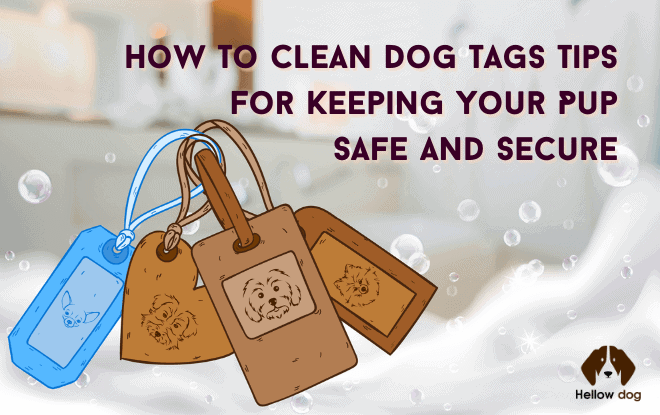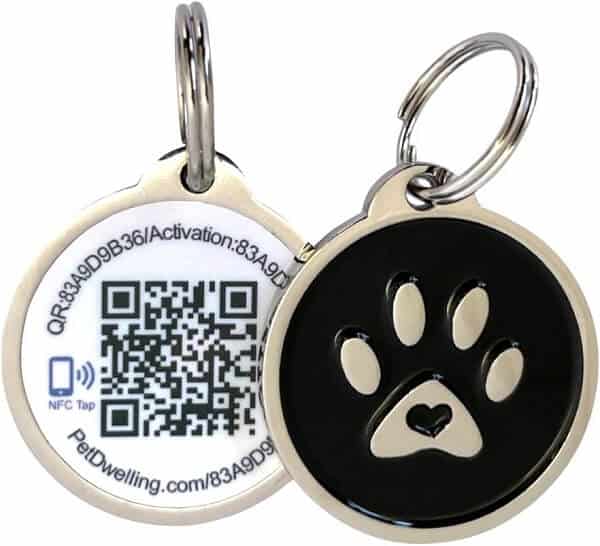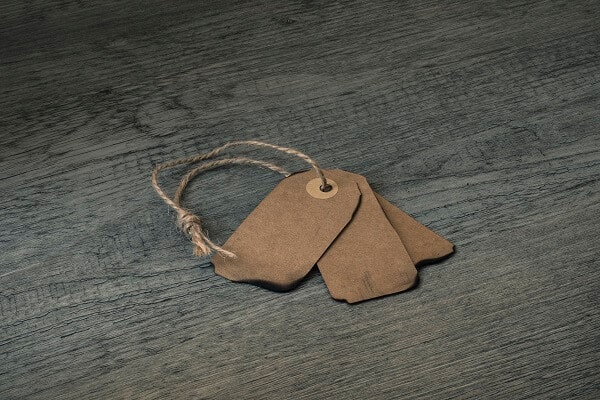Dog tags are essential for your pet’s identification and safety. They contain vital information such as your dog’s name, address, and phone number. However, over time, dog tags can become dirty, rusty, and faded, making it difficult to read the information on them. In this article, we will guide you on how to clean your dog’s tags to ensure they are always readable and in good condition.

The Importance of Dog Tags
Dog tags, also known as identification tags, are small metal plates or discs that are worn by dogs on their collars or harnesses. They contain important information about the dog, including their name, owner’s name, and contact information. Dog tags have been a crucial tool for pet owners for many years and are an essential aspect of responsible dog ownership.
Identification
Dog tags are the most effective and efficient way of identifying your dog. If your dog goes missing or gets lost, a person who finds them can quickly identify the dog and return them to you. The information on the dog tag will help the person who finds your dog to contact you. This can save valuable time and can help reunite you with your dog faster. In cases where the dog is injured or sick, having identification tags can help people provide the necessary care to the dog.
Legal Requirements
In many places, it is mandatory to have dog tags. For instance, in some states in the US, dogs are required to wear identification tags. The tags must have the owner’s name, address, and phone number. Failure to comply with this requirement can lead to legal consequences. It is essential to ensure that your dog complies with the local laws regarding dog tags. In this way, you will avoid any unnecessary legal problems.
Medical Information
Dog tags can also contain medical information about your dog. This can be helpful in case of emergencies. For example, if your dog has an allergy or any medical condition, this information can be included on the dog tag. In case your dog needs medical attention, people will be aware of any relevant medical information, and they can provide the right care to your dog.
Convenience
Dog tags are also convenient. It is much easier for people to read a dog tag than it is to scan a microchip. In addition, dog tags can be changed quickly, making it easier to update the information. This is particularly useful if you move or change phone numbers. Changing the information on a dog tag is a simple process that can be done at any time.
Peace of Mind
Finally, dog tags offer peace of mind to pet owners. Knowing that your dog is wearing a tag with all the necessary information can help you relax and enjoy the time with your dog. You will not have to worry about what will happen if your dog goes missing or gets lost. You will know that your dog has a better chance of being found and returned to you.
How to clean different types of dog tags?
1. Why Do You Need to Clean Dog Tags?
Before we dive into the cleaning process, let’s first understand why cleaning your dog’s tags is essential. Over time, dog tags accumulate dirt, grime, and other particles that can make them less legible. This can be problematic if your dog gets lost, and the tags are unreadable. Cleaning your dog’s tags will help ensure that they remain in good condition and are always readable, should an emergency arise.
2. What Do You Need to Clean Dog Tags?
To clean your dog’s tags, you’ll need a few supplies, including:
- A small bowl
- Warm water
- Mild dish soap
- Soft-bristled toothbrush or sponge
- Microfiber towel or soft cloth
3. How to Clean Metal Dog Tags?
Metal dog tags are the most common type of tag and are relatively easy to clean. Follow these steps to clean metal dog tags:
- Remove the tag from the collar.
- In a small bowl, mix warm water and a few drops of mild dish soap.
- Place the tag in the bowl and let it soak for a few minutes.
- Use a soft-bristled toothbrush or sponge to gently scrub the tag, paying special attention to the text and edges.
- Rinse the tag thoroughly under running water.
- Dry the tag with a microfiber towel or a soft cloth.
4. How to Clean Plastic Dog Tags?
Plastic dog tags are less common than metal tags, but they’re still popular among pet owners. To clean plastic dog tags, follow these steps:
- Remove the tag from the collar.
- In a small bowl, mix warm water and a few drops of mild dish soap.
- .Dip a soft-bristled toothbrush or sponge into the soapy water.
- Use the toothbrush or sponge to gently scrub the tag, paying special attention to the text and edges.
- Rinse the tag thoroughly under running water.
- Dry the tag with a microfiber towel or a soft cloth.
5. How to Remove Stubborn Stains on Dog Tags?
If your dog’s tags have stubborn stains that won’t come off with mild dish soap, you can use a few drops of white vinegar. Follow these steps:
- Remove the tag from the collar.
- In a small bowl, mix warm water and a few drops of white vinegar.
- Place the tag in the bowl and let it soak for a few minutes.
- Use a soft-bristled toothbrush or sponge to gently scrub the tag, paying special attention to the stained areas.
- Rinse the tag thoroughly under running water.
- Dry the tag with a microfiber towel or a soft cloth.
Tips for Maintaining Your Dog’s Tags
Over time, tags can become dirty, scratched, or faded, making them difficult to read. To ensure that your dog’s tags are always visible and legible, try the following tips:
- Check your dog’s tags regularly to make sure they’re still attached and readable.
- Clean your dog’s tags with soap and water to remove dirt and grime.
- Use a soft cloth to dry the tags, and avoid using abrasive materials that could scratch the surface.
- Consider using a tag silencer or tag protector to reduce noise and prevent tags from rubbing against each other, which can cause them to wear out faster.
By keeping your dog’s tags clean and readable, you can ensure that your pet is easily identifiable and that you can be contacted if they get lost.
Safety Tips for Your Pup: What Precautions Should You Take When Tagging Your Dog?
As a responsible pet owner, it is crucial to ensure the safety and well-being of your furry companion.
1.Choose the Right Collar and Tag Material
Choosing the right collar and tag material is critical when it comes to your dog’s safety. A sturdy and durable collar made of leather or nylon is ideal for attaching a tag. Metal tags are the most commonly used and are durable and long-lasting. However, they can be noisy and cause irritation to your dog’s skin. Consider using a plastic or rubber tag if you have a sensitive dog. These tags are lightweight and less noisy.
2.Keep the Tag Information Up-to-date
Your dog’s tag should contain up-to-date information such as your name, phone number, and address. It is crucial to ensure that this information is correct and updated regularly. If you move or change your phone number, make sure to update your dog’s tag information. This information can help reunite you with your dog in case it gets lost.
3.Use a Harness for Small Breeds or Short-nosed Breeds
Small breeds and short-nosed breeds such as Pugs, Boston Terriers, and Bulldogs are prone to neck injuries. In such cases, it is better to use a harness instead of a collar to attach the tag. A harness distributes the weight evenly and reduces the strain on the neck. It also provides better control when walking your dog.
4.Check the Tag Regularly
Inspect your dog’s tag regularly to ensure it is still attached and readable. Over time, the tag may become worn out, and the information may become illegible. Check the tag for wear and tear and replace it if necessary. It is also essential to ensure that the tag is still attached to the collar or harness
FAQs:
Q: Can I clean my dog’s tags in the dishwasher?
No, it is not recommended to clean dog tags in the dishwasher as it can damage them.
Q: How often should I clean my dog’s tags?
It is recommended to clean your dog’s tags at least once a week or more if they get dirty frequently.
Q:Can I use vinegar to clean my dog’s tags?
Yes, you can use vinegar to clean your dog’s tags. Mix equal parts of water and vinegar and soak the tags for a few minutes before wiping them with a soft cloth.
Q:How do I remove rust from my dog’s tags?
Mix baking soda and water to make a paste and apply it to the rusted area. Let it sit for a few minutes before scrubbing it with a soft-bristled brush. Rinse with water and dry thoroughly.
Q: What information should I include on my dog’s tag?
At a minimum, include your contact details and your dog’s name. You can also include any medical conditions or medication they may be taking.
Q: What should I do if my dog loses their tag?
Replace the tag as soon as possible to ensure your dog’s safety. In the meantime, keep a close eye on your dog and make sure they are always wearing its collar.
Q: Do I need to replace my dog’s tag if I move?
Yes, if you move, you need to update your dog’s tag with the new address and phone number. This will ensure that the information on the tag is current and accurate.
Q: What if my dog loses their tag?
If your dog loses their tag, you should replace it as soon as possible. You can purchase a new tag or have one made at a local pet store.
Q: Can I use a microchip instead of a dog tag?
While microchips are a popular form of identification for dogs, they are not a replacement for dog tags. Microchips require a scanner to read the information, and not everyone has access to a scanner. Additionally, not all animal shelters or veterinary clinics have the necessary equipment to scan for microchips. Having a dog tag ensures that anyone who finds your dog can easily and quickly identify them and contact you.
Q: How to Prevent Dog Tags from Getting Dirty Quickly?
Cleaning your dog’s tags regularly will help keep them in good condition, but there are a few other things you can do to prevent them from getting dirty quickly. Here are some tips:
- Remove the tags from the collar when giving your dog a bath.
- Avoid using harsh chemicals
- Avoid letting your dog wear the collar and tags when playing in muddy areas or swimming.
- Consider using tag silencers or tag pouches to protect the tags from wear and tear.
Conclusion
Cleaning your dog’s tags regularly is important for their identification and safety. By following the steps and tips mentioned in this article, you can keep your dog’s tags in good condition and extend their lifespan. Remember to avoid using harsh chemicals and always store the tags in a safe and dry place. By taking care of your dog’s tags, you can ensure their safety and well-being.









